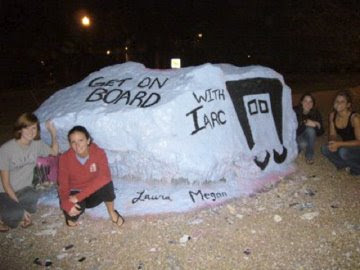
The Mobile above was made by Alexander Calder in 1972, and given as a gift by the collectors committee. It is one of the first mobiles ever made, and consists of steel wire and aluminum. The aluminum is painted red and blue, with the wires connecting each aluminum shape with one another in a visually appealing design. The shapes are rounded and slightly geometric with thin wires to create contrast The negative space of this work is especially intriguing because there is so much negative space that the feeling of the mobile floating is very prominent. The mobile idea, invented my Calder himself, is successful in this sculpture because of its negative space. Also, the colors are important in this work because the primary colors are fairly bright against the dark grey wire, creating a contrast. One last thing that is interesting about this piece is the symmetry. It is unbalanced yet it still floats in a straight line. This makes the piece different from anything else before or after it.
One piece of work that is fairly similar to this mobile is the curtain by Marian Mahler. It is a red curtain with a print that consists of yellow, white and black shapes coming down from strings. This reminds me of the mobile because of the way it is suspended. Also, the colors are similar because the red background is bright and the colored shapes on the foreground are brighter and darker than the red to create a contrast just like Calder’s piece. One other thing I noticed was the negative space in this work. It isn’t the same as the mobile, but it was used with the same idea.
Le Corbusier’s loveseat is one artifact that is completely different from the mobile. It is a larger piece for one, but it also has no negative space. The chair is very grounded because of it’s size and shape. Also, instead of organic shapes and curves, this chair has only straight lines.









 All the images above are process pictures for my Shelter Bus. The shelter bus is a bus for four relief workers to stay, and a place that will hopefully help out the community as well. I changed my mind over five times on the design of my bus because I felt my concept wasn't strong enough with the design. I needed to make the concept be a reflection of the overall design of my bus. First, I had a very plain bus design (from the top images) that was supposed to reflect "gravity" then I changed to a rotating bus that involved the concept of rotation, and then finally I came to the idea of Lustre. Most of the images above show my process of drawing on trashpaper, on the back of random pieces of paper, and also making little sketch models to help me become inspired with a good design.
All the images above are process pictures for my Shelter Bus. The shelter bus is a bus for four relief workers to stay, and a place that will hopefully help out the community as well. I changed my mind over five times on the design of my bus because I felt my concept wasn't strong enough with the design. I needed to make the concept be a reflection of the overall design of my bus. First, I had a very plain bus design (from the top images) that was supposed to reflect "gravity" then I changed to a rotating bus that involved the concept of rotation, and then finally I came to the idea of Lustre. Most of the images above show my process of drawing on trashpaper, on the back of random pieces of paper, and also making little sketch models to help me become inspired with a good design.




 These last images are the final product. The bus transforms outward (like my concept of lustre) and all the materials used reflect the idea of lustre as well.
These last images are the final product. The bus transforms outward (like my concept of lustre) and all the materials used reflect the idea of lustre as well.




































